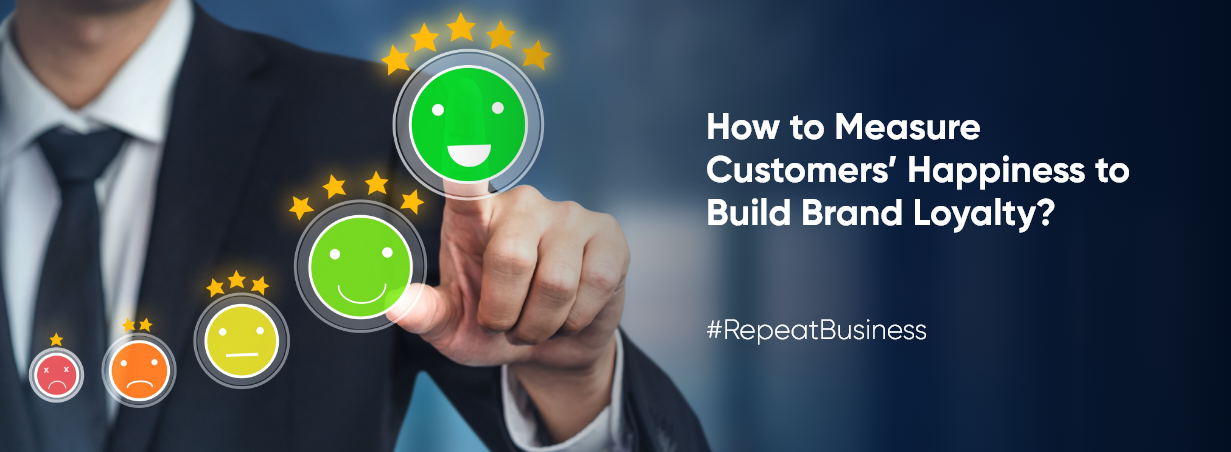How to Measure Customers’ Happiness to Build Brand Loyalty?
- Posted on January 12, 2024 by Robert
- Reading time about 5 minutes
Customer satisfaction and happiness are two distinct objectives for a new-age business. Technology has revamped the way customers perceive the brand and interact with it. It isn’t only about how they like a product or service. It has become far more extensive than that.
From marketplaces moving to digital platforms and customers finding emotional connections with a brand, brand loyalty has evolved. Happy customers stick with a brand despite having better options in the market. The reason is quite simple. They connect to the brand ethos and would stick to it no matter what. Customer satisfaction, on the other hand, is more about how they rate their experience doing business with a brand.
This blog will offer you an in-depth view of brand loyalty and the role customer happiness plays in it.
What is customer loyalty, and how different is it from brand loyalty?
When a customer returns to do business with you repeatedly, you can say you have built customer loyalty. Customer loyalty is an inclination to choose a brand repeatedly despite having other options in the market. The reasons can be plentiful, such as product quality, customer support, and a great experience leading to customer satisfaction.
Customer loyalty comes with a bundle of benefits, such as:
· Higher purchase volume
· Referrals via word-of-mouth
· Better Credibility
Brand loyalty, on the other hand, is a long-term value that a brand earns when they build an emotional connection with their customers and their association extends beyond repeat business. Here, customers extend their loyalty beyond a certain product or service. They become brand advocates who are also consuming other products from the same brand.
Customer happiness is a common factor!
Customer happiness is a crucial achievement for building customer and brand loyalty. Happy customers tick with a brand and provide repeat business, building both customer and brand loyalty. When a brand succeeds in providing consistent customer satisfaction and experience, customers tend to become loyal to the brand.
Different Ways You Can Measure Customer Happiness
It is important to measure customer happiness to launch a remedial plan in case there are any gaps. Customer and brand loyalty are important to ensure steady profits, lower CAC, and business growth. Here are five unique ways to measure customer happiness.
Measure Customer Satisfaction
Customer satisfaction is an integral part of customer happiness, and that’s why it can be an effective medium to understand how happy your customers are with your brand. You can ask for customers’ feedback to know what their pain points are and accordingly design loyalty programs.
Addressing pain points can pave the path for more customer satisfaction, which over time can lead to customer happiness. Loyalty programs specifically designed to enhance customer satisfaction address the pain points collected through customer satisfaction measurement initiatives.
Point-based rewards, tiered rewards, cashback offers, and gamification are some examples of loyalty programs that impact customer satisfaction positively.
Make Use of Customer Happiness Metrics
Brands that use one or another metric to calculate customer satisfaction and happiness are likely to be more successful than those that don’t. Customer happiness metrics help map the customer experience and provide brands with the required information to design more relevant loyalty programs. It’s better not to rely on a single metric. Using two or more customer happiness metrics provides a comprehensive view of customer happiness.
· Customer Happiness Score (CSAT)
CSAT is the metric used by businesses to measure the satisfaction level of customers with a product or service. Customers are asked to rate their satisfaction with a recent interaction, purchase, or overall experience on a scale. The scale often ranges from 1 to 5 or 1 to 7, with 1 being “very dissatisfied” and the highest number being “very satisfied.”
· Net Promoter Score (NPS)
The Net Promoter Score (NPS) is a popular metric for assessing customer loyalty and satisfaction. NPS is designed to measure the likelihood of customers recommending a company’s products or services to others.
· Customer Effort Score (CES)
CES is a useful metric used by businesses to assess the ease with which customers can complete specific tasks, such as making a purchase, resolving a complaint, or providing customer support.
· Daily Active Users to Monthly Active Users Ratio
It is one of the key metrics that help businesses assess the engagement level of their users over a specific period. This ratio offers insights into how often users interact with a product.
Include Feedback Form in your Customer Loyalty Program
Feedback surveys or forms are an effective way to ascertain if customers are happy with your brand or not. By embedding survey forms or feedback forms in your customer loyalty program, you can prompt customers to share what they think without making it a tedious process. Your loyalty platform can even reward customers for submitting their feedback. It will encourage more customers to fill out surveys. The more data you have, the better the chances are for improvement.
For example, customers can be asked to rate their recent experience while redeeming their points. This way, they don’t have to make any extra effort, and it will increase the chances of them sharing their pain points.
Make it Easy with a SaaS Based Loyalty Program
Customer happiness should be your priority as a brand. When you focus on enhancing customer happiness, you tend to create more customized customer loyalty programs. To achieve this objective hassle-free, you must invest in SaaS-based loyalty software.
Novus Loyalty is a reliable loyalty management platform that can upgrade your customer loyalty programs to meet all the criteria that are required for customer happiness.



